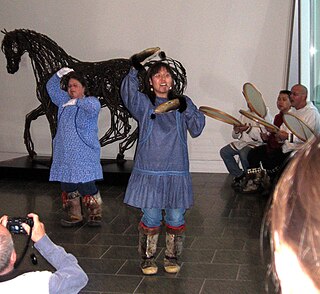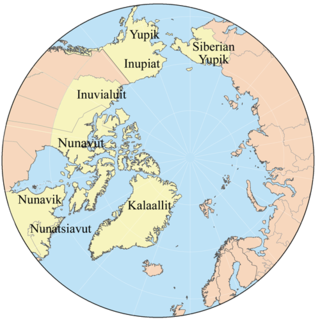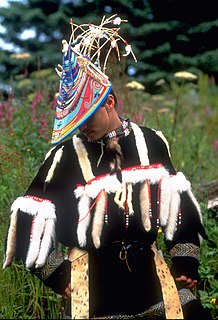This article may be expanded with text translated from the corresponding article in Turkish. (October 2014)Click [show] for important translation instructions.
|

Yup'ik masks (Yup'ik kegginaquqsgkegginaqukdualkegginaqutpl and nepcetaqsgnepcetatpl; in the Lower Yukon dialects avangcaqsgavangcakdualavangcatpl ; in Nunivak Cup'ig dialect agayu) are expressive shamanic ritual masks made by the Yup'ik people of southwestern Alaska. Also known as Cup'ik masks for the Chevak Cup'ik dialect speaking Eskimos of Chevak and Cup'ig masks for the Nunivak Cup'ig dialect speaking Eskimos of Nunivak Island. One of their most popular forms of the Alaska Native art are masks. The Yup'ik masks vary enormously but are characterised by great invention. They are typically made of wood, and painted with few colors. The Yup'ik masks were carved by men or women, but mainly were carved by the men. The shamans (angalkuq) were the ones that told the carvers how to make the masks. Yup'ik masks could be small three-inch finger masks or maskettes (or dance fans, in the Lower Yukon Yup'ik dialects tegumiaqsgtegumiakdualtegumiatpl), but also ten-kilo masks hung from the ceiling or carried by several people. These masks are used to bring the person wearing it luck and good fortune in hunts. Over the long winter darkness dances and storytelling took place in the qasgiq using these masks. They most often create masks for ceremonies but the masks are traditionally destroyed after being used. After Christian contact in the late nineteenth century, masked dancing was suppressed, and today it is not practiced as it was before in the Yup'ik villages. [1] [2] [3]

Masks among Eskimo peoples served a variety of functions. Masks were made out of driftwood, animal skins, bones and feathers. They were often painted using bright colors. There are archeological miniature maskettes made of walrus ivory, coming from early Paleo-Eskimo and from early Dorset culture period.

Alaska is a U.S. state in the northwest extremity of North America, just across the Bering Strait from Asia. The Canadian province of British Columbia and territory of Yukon border the state to the east, its most extreme western part is Attu Island, and it has a maritime border with Russia to the west across the Bering Strait. To the north are the Chukchi and Beaufort seas—southern parts of the Arctic Ocean. The Pacific Ocean lies to the south and southwest. It is the largest state in the United States by area and the seventh largest subnational division in the world. In addition, it is the 3rd least populous and the most sparsely populated of the 50 United States; nevertheless, it is by far the most populous territory located mostly north of the 60th parallel in North America: its population—estimated at 738,432 by the United States Census Bureau in 2015— is more than quadruple the combined populations of Northern Canada and Greenland. Approximately half of Alaska's residents live within the Anchorage metropolitan area. Alaska's economy is dominated by the fishing, natural gas, and oil industries, resources which it has in abundance. Military bases and tourism are also a significant part of the economy.
While the Iñupiaq and Yup'ik Eskimos are culturally and ethnically related, separated only by language differences and, often, hundreds of miles of territory, they have developed distinct versions of similar traditional mask forms. In the case of the Iñupiaq, masks are typically less elaborate than those made by their Yup'ik neighbors to the south-east, and usually smaller, covering only the face. [4]








